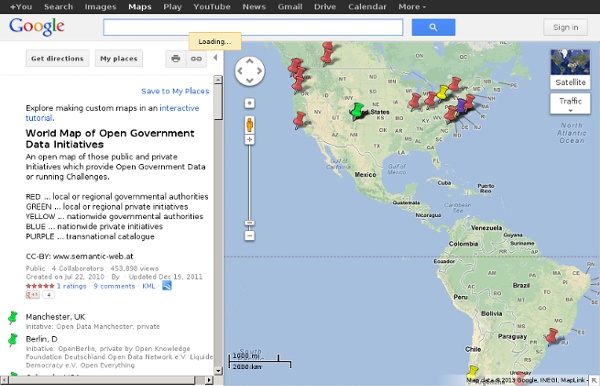



Liens utiles Commentaires Les think-tanks qui en parlent Libertic : Regards Citoyens : www.regardscitoyens.org Acteurs Publics : www.acteurspublics.com/article/28-09-10/les-portails-etrangers-au-banc-d-essai La Lettre du Secteur Public : www.lalettredusecteurpublic.fr/page2.asp? La Fing : www.fing.org/? Open Data en France Projet de la ville de Rennes : www.data.rennes-metropole.fr/ Données de transport de la ville de Rennes : Données publiques Paris : Open Data de l’agglomération de Montpellier : Première assise des données publiques : www.aecom.org/Vous-informer/Evenements/Premieres-Assises-des-donnees-publiques-ouvertes-en-Aquitaine-le-6-decembre Le blog de la mission chargée de créer data.gouv.fr : Annuaire et portail de vente des données publiques : Open Data dans le monde
Data Catalog Innovation in government: Brazil - McKinsey Quarterly - Public Sector - Management Historically, Brazilians had no visibility into government spending—which areas got funding, how efficiently public money was being used, or whether fraudulent activity was occurring. Over the past few decades, many high-profile incidents of flagrant corruption have sorely tested the public’s trust, hurt Brazil’s image in the corporate sector, and hampered economic growth. In the World Bank and IFC Enterprise Surveys 2009, 70 percent of global and domestic companies responding said they viewed corruption as a “major constraint to doing business” in Brazil. In 2004, believing that transparency would increase citizen engagement, encourage responsible public spending, and deter corruption, Brazil’s Office of the Comptroller General (which goes by the Portuguese abbreviation CGU) created an open-access Web portal with data on federal expenditures. Although CGU encountered resistance from government officials when it first launched the portal, it remained committed to full disclosure.
LiberTIC Data.gov Ontario Becomes Latest Province to Launch Open Data Portal Ontario residents are getting a behind-the-scenes glimpse at the place they call home. This month, Ontario became the latest province to launch an open data portal. Currently, the database contains 63 files on various topics, including roadwork, geology, and tourism in the province. The online portal is easy to use and files can be downloaded directly from the website onto a PC. Ontario’s open data portal was first announced by MPP Glen Murray in 2011. The goal of the portal is to make statistical information accessible to the general public, including developers and designers. According to the official website, users are permitted to copy and adapt the data for commercial purposes. The Ontario portal joins multiple open data projects that are already underway throughout the country. The availability of government statistics has encouraged Canadian developers and entrepreneurs. Open-access portals have also encouraged Canadians to get more engaged in local government.
the 5 stars of open linked data While perusing the minutes of today’s w3c egov telecon I noticed mention of Tim Berners-Lee’s Bag of Chips talk at the gov2.0 expo last week in Washington, DC. I actually enjoyed the talk not so much for the bag-of-chips example (which is good), but for the examination of Linked Data as part of a continuum of web publishing activities associated with gold stars, like the ones you got in school. Here they are: I think it’s helpful to think of Linked Data in this context, and not to minimize (or trivialize) the effort and the importance of getting the first 3 stars. It was interesting that he didn’t mention RDF once (unless I missed it) and talked instead about Linked Data Format.
Green.sba.gov - API's for Apps for Entrepreneurs Challenge The Socrata Open Data API (SODA) allows software developers to access data hosted in Socrata data sites programmatically. Developers can create applications that use the SODA APIs to visualize and “mash-up” Socrata datasets in new and exciting ways. Create an iPhone application that visualizes government spending in your area, a web application that allows citizens to look up potential government benefits they'd overlooked, or a service that automatically emails you when new earmarks are added to bills that you wish to track. To start accessing this dataset programmatically, use the API endpoint provided below. For more information and examples on how to use the Socrata Open Data API, reference our Developer Documentation. API Access Endpoint: Create a spreadsheet in Microsoft Excel to analyze or visualize this dataset. Use Microsoft Excel 2010, Microsoft Excel 2013 or Microsoft Power Query. Copy this link:
Sharing Spatial Data One of the key enabling technologies introduced in the early days of AM/FM/GIS systems was long transactions, also known as data versioning. Long transactions make it possible to store spatial design data in the same database as as-built data, enabling design engineers to work on new designs at the same time as operations staff are relying on as-built information to operate and maintain active utility networks. The first commercial systems implementing this technology in the early 1990's were IBM's GFIS which ran on DB2, Intergraph FRAMME, and VISION* which managed versioned spatial data in an Oracle RDBMS (this was long before Oracle Spatial and Workspace Manager). As I remember, San Diego Gas & Electric and BC Hydro were GFIS sites. The largest FRAMME site was Ameritech, now part of AT&T. Smallworld implemented long transactions in 1996. Each of these early implementations implemented long transactions in a quite different way. f open source projects are hosted on GitHub.